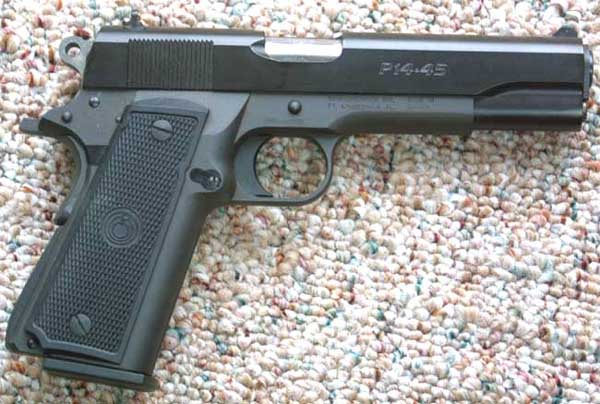 The Para-Ordnance P14-45
The Para-Ordnance P14-45
| Dimensions |
Barrel Length |
Weight |
Caliber |
Action Type |
Magazine Capacity |
| 8 ½ Inches |
5 Inches |
40oz. |
.45 A.C.P. |
S.A. Semi Auto |
14+1 |
One of my very favorite pistols, and my first choice
for carry and defense. This is a semi automatic based on the classic Colt
Government model designed by John M. Browning, but with a number of improvements.
The most obvious advance is in the magazine capacity of 14 rounds, as opposed
to the original gun's 7 round mag. Almost as important is the integral
feed ramp, and fully supported chamber. The integral feed ramp makes feed
failures much less likely. The fully supported chamber eliminates one of
the great weaknesses of the gun. In the initial design, a cut out was left
in the bottom of the chamber. This was to smooth the feeding and extraction
of the cartridge, but it proved to be an Achilles heel. The cut out left
a portion of the cartridge unsupported so that pressures could not exceed
19,900 cpu. What this means in the real world is that a standard 230 grain
bullet can not be accelerated much past 800 or 900 feet per second. This
was not seen as a problem back in 1911 when the gun was first adopted. The
bench mark for stopping power in those days was the old .45 long colt of
cowboy fame. The new .45 A.C.P. duplicated the old cartridge in power, but
in a much smaller package. On top of this it held seven rounds instead of
the six (or in some cases five if the common practice of leaving an empty
chamber under the hammer was followed) that the old revolver held, and could
be reloaded in a fraction of the time by inserting a magazine. The gun
served in the armed forces for over seventy years, and is still in limited
issue.
The new Para-Ordnance is no thicker than the standard
Government Model, and the design is so similar that the entire top portion
of the gun can be interchanged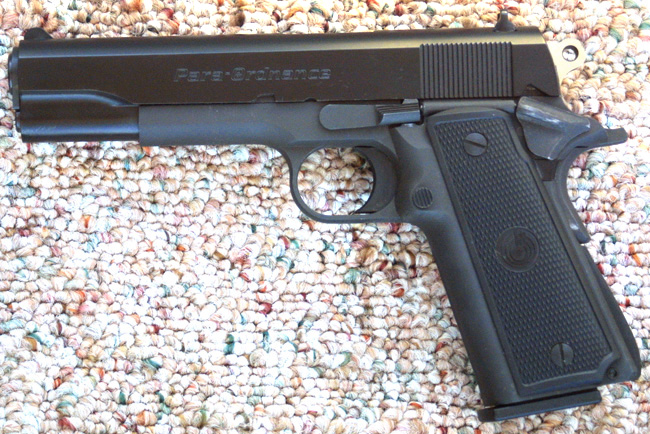 with that of the Colt model. There have been a number of experiments
with full chambered guns (like the P14-45), in which loads approaching and
even exceeding .44 magnum power have been used. These experiments led to
the production of the .45 super cartridge. Unlike other magnum cartridges,
these can be chambered in the a standard caliber arm and so care must be
taken not to mix them with standard .45 loads. Ammunition and components
are available, or you can make your own by cutting down a .308 rifle cartridge.
I have made a number of rounds like this, and they do work. I have also read
of people trimming Detonics .451 magnum shells down, but as rare and expensive
as this now defunct ammo is, it seems like a bit of a waste. The addition
of a shock buffer, and a beefed up recoil spring gives what is essentially
a 15 shot semi automatic, firing a cartridge which can edge out the standard
loadings of the .44 magnum in power. As if this were not enough, the gun
is a great shooter. It is accurate and has a excellent sights (even if they
are of the three dot variety). It also has a hard black finish which protects
the piece much better than traditional bluing.
with that of the Colt model. There have been a number of experiments
with full chambered guns (like the P14-45), in which loads approaching and
even exceeding .44 magnum power have been used. These experiments led to
the production of the .45 super cartridge. Unlike other magnum cartridges,
these can be chambered in the a standard caliber arm and so care must be
taken not to mix them with standard .45 loads. Ammunition and components
are available, or you can make your own by cutting down a .308 rifle cartridge.
I have made a number of rounds like this, and they do work. I have also read
of people trimming Detonics .451 magnum shells down, but as rare and expensive
as this now defunct ammo is, it seems like a bit of a waste. The addition
of a shock buffer, and a beefed up recoil spring gives what is essentially
a 15 shot semi automatic, firing a cartridge which can edge out the standard
loadings of the .44 magnum in power. As if this were not enough, the gun
is a great shooter. It is accurate and has a excellent sights (even if they
are of the three dot variety). It also has a hard black finish which protects
the piece much better than traditional bluing.
The Para Ordnance made it's first appearance as a
lower frame conversion kit. The idea was that you would by use your old
slide, barrel, etc. to make a new gun with increased firepower. The kits
went over very well, but many people did not like the idea of discarding
a perfectly good Colt Auto frame, so there came to be a demand for a complete
gun. These 14 round pistols are produced in Canada, where it is not legal
for a civilian to posses a pistol, and then sold in the U.S. where, for
years, it was not legal for a mere civilian to buy a new magazine which
holds over ten rounds. During the ban, the guns came with a 10 round magazine,
but included a certificate for the purchase of a pair of 14 round magazines
for $100. Happily, the ban has ended in most of America, though there are
a few backward areas which have not yet come into the 21st century.
Disassembly
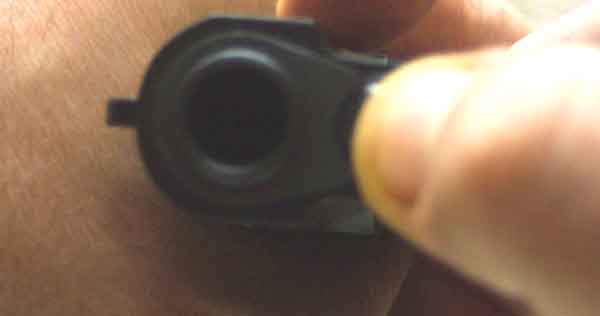
|
The Para-Ordnace takes down in essentially the same
manner as the standard M1911 pistol. The process is begujn, by pressing
in on the recoil spring plug, under the muzzle of the gun. This will allow
the barrel bushing to be turned ninety degrees to the left.
|
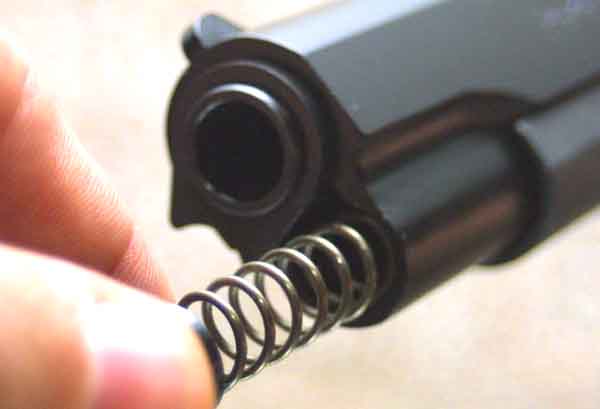
|
The spring tension should be released, and the spring
left in place.
|
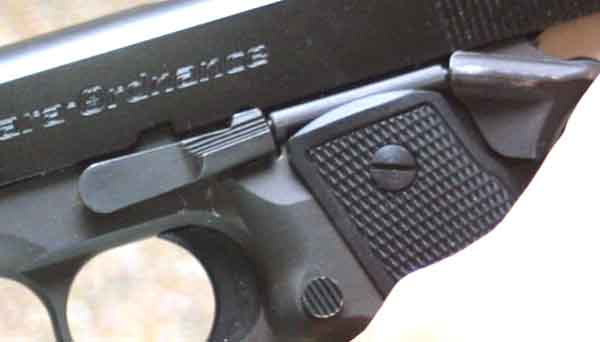
|
The slide shoudl now be pulled back, until the disassembly
notch is lined up with the end of the slide stop.
|
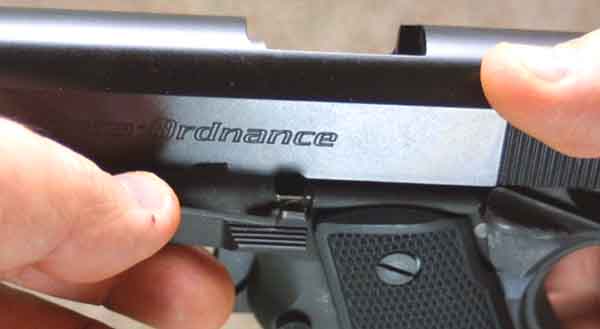
|
The slide stop may be removed by pulling quickly
out of the left side of the frame.This can sometimes be a matter of some difficulty,
as there is a spring loaded catch in place.
|
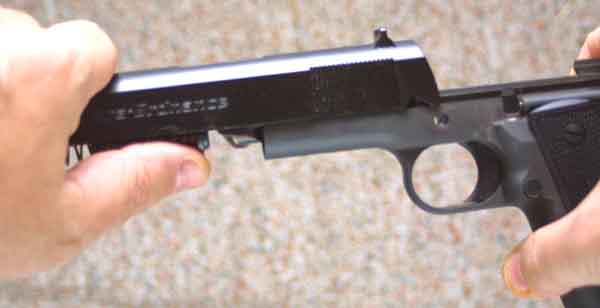
|
The slide can now be pulled forward off of the frame.
|
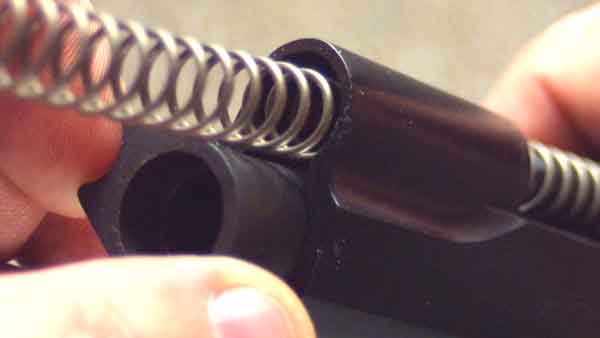
|
The barrel busing can now be turned to the left,
and removed, allowing disassembly of the slide section.
|
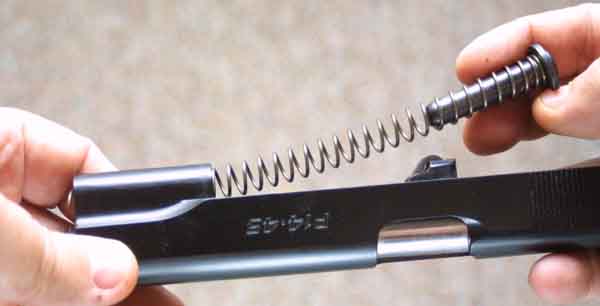
|
The recoil spring, and guide, may be removed by
pulling up and back.
|
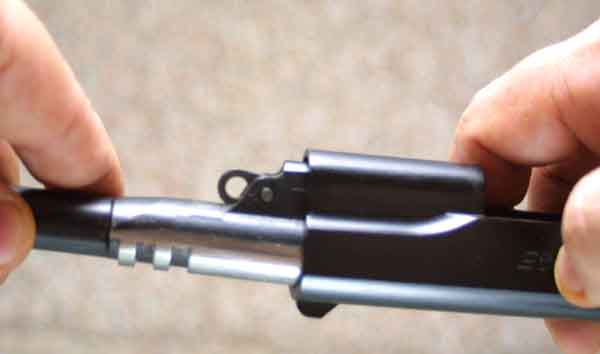
|
The barrel may now be pulled forward, out of the
slide.
|
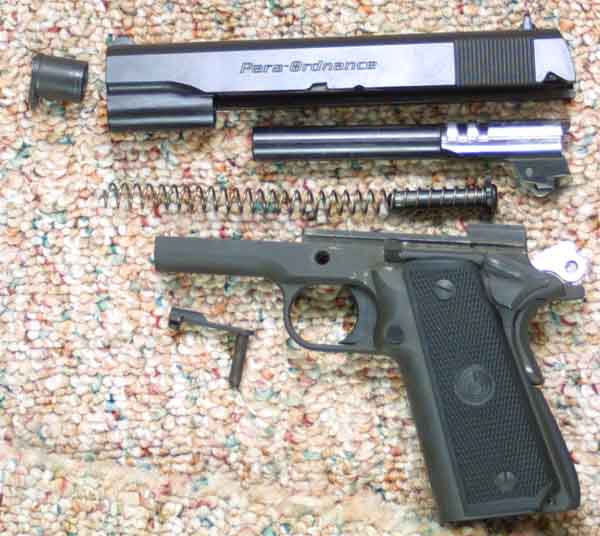
|
The Para-Ordnance P-14, stripped for cleaning, and
looking much like a pre 70 Colt Government model, with a solid barrel bushing.
|
|
 The Para-Ordnance P14-45
The Para-Ordnance P14-45